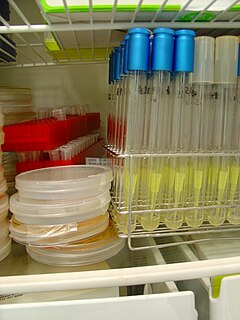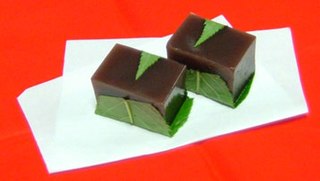
Gram-positive bacteria are bacteria that give a positive result in the Gram stain test, which is traditionally used to quickly classify bacteria into two broad categories according to their cell wall.

A microbiological culture, or microbial culture, is a method of multiplying microbial organisms by letting them reproduce in predetermined culture medium under controlled laboratory conditions. Microbial cultures are foundational and basic diagnostic methods used extensively as a research tool in molecular biology.

Coliform bacteria are defined as rod-shaped Gram-negative non-spore forming and motile or non-motile bacteria which can ferment lactose with the production of acid and gas when incubated at 35–37°C. They are a commonly used indicator of sanitary quality of foods and water. Coliforms can be found in the aquatic environment, in soil and on vegetation; they are universally present in large numbers in the feces of warm-blooded animals. While coliforms themselves are not normally causes of serious illness, they are easy to culture, and their presence is used to indicate that other pathogenic organisms of fecal origin may be present. Such pathogens include disease-causing bacteria, viruses, or protozoa and many multicellular parasites. Coliform procedures are performed in aerobic or anaerobic conditions.

A growth medium or culture medium is a solid, liquid or semi-solid designed to support the growth of microorganisms or cells, or small plants like the moss Physcomitrella patens. Different types of media are used for growing different types of cells.

Shigella dysenteriae is a species of the rod-shaped bacterial genus Shigella. Shigella species can cause shigellosis. Shigellae are Gram-negative, non-spore-forming, facultatively anaerobic, nonmotile bacteria.

The oxidase test is a test used in microbiology to determine if a bacterium produces certain cytochrome c oxidases. It uses disks impregnated with a reagent such as N,N,N′,N′-tetramethyl-p-phenylenediamine (TMPD) or N,N-dimethyl-p-phenylenediamine (DMPD), which is also a redox indicator. The reagent is a dark-blue to maroon color when oxidized, and colorless when reduced. Oxidase-positive bacteria possess cytochrome oxidase or indophenol oxidase. These both catalyze the transport of electrons from donor compounds (NADH) to electron acceptors . The test reagent, TMPD dihydrochloride acts as an artificial electron donor for the enzyme oxidase. The oxidized reagent forms the colored compound indophenol blue. The cytochrome system is usually only present in aerobic organisms that are capable of using oxygen as the terminal electron acceptor. The end-product of this metabolism is either water or hydrogen peroxide.

In microbiology, streaking is a technique used to isolate a pure strain from a single species of microorganism, often bacteria. Samples can then be taken from the resulting colonies and a microbiological culture can be grown on a new plate so that the organism can be identified, studied, or tested.
Instruments used specially in microbiology are as follows:

A Chamberland filter, also known as a Pasteur–Chamberland filter, is a porcelain water filter invented by Charles Chamberland in 1884. It is similar to the Berkefeld filter in principle.
McIntosh and Filde's anaerobic jar is an instrument used in the production of an anaerobic environment. This method of anaerobiosis as others is used to culture bacteria which die or fail to grow in presence of oxygen (anaerobes).

Nutrient agar is a general purpose medium supporting growth of a wide range of non-fastidious organisms. It typically contains (mass/volume):
The citrate test detects the ability of an organism to use citrate as the sole source of carbon and energy.
Mannitol motility medium is a bacterial growth medium used to detect the ability of bacteria to ferment mannite and produce nitrogen gas; and to indicate the motility of the organism.
Lautropia mirabilis is a Gram-negative, facultatively anaerobic, oxidase- and catalase-positive, motile bacterium of the genus Lautropia and family Burkholderiaceae, isolated from the mouth of children who were infected with human immunodeficiency virus.
Agar dilution is one of two methods used by researchers to determine the Minimum Inhibitory Concentration (MIC) of antibiotics. It is the dilution method most frequently used to test the effectiveness of new antibiotics when a few antibiotics are tested against a large panel of different bacteria.
In microbiology, the term isolation refers to the separation of a strain from a natural, mixed population of living microbes, as present in the environment, for example in water or soil flora, or from living beings with skin flora, oral flora or gut flora, in order to identify the microbe(s) of interest. Historically, the laboratory techniques of isolation first developed in the field of bacteriology and parasitology, before those in virology during the 20th century. Methods of microbial isolation have drastically changed over the past 50 years, from a labor perspective with increasing mechanization, and in regard to the technology involved, and hence speed and accuracy.

An inoculation needle is a laboratory equipment used in the field of microbiology to transfer and inoculate living microorganisms. It is one of the most commonly implicated biological laboratory tools and can be disposable or re-usable. A standard reusable inoculation needle is made from nichrome or platinum wire affixed to a metallic handle. A disposable inoculation needle is often made from plastic resin. The base of the needle is dulled, resulting in a blunted end.
Sulphide Indole Motility (SIM) medium is a bacterial growth medium which tests for the ability to reduce sulfates, the ability to produce indoles, and motility. This combination of challenges in one mixture is convenient and commercially available in stab tubes. Inoculated needles are then punctured into the culture and incubated, if the culture becomes cloudy the bacteria were able to infiltrate the media and survive. This method is particularly useful for pathogenic bacteria which are dangerous to handle on wet mount slides
Vibrio aerogenes is a gram-negative organism that is rod-shaped and has a two-sheathed flagella that is found on one side of the cell that makes it motile. When it is grown on polypeptone-yeast (PY) plate medium, the colonies are usually round and flat. It is an organism that is mesophilic which means it likes temperatures that are between 20-45°C. In addition, it is facultatively anaerobic, which means it can survive with or without oxygen. This is a marine bacteria that is most commonly found in temperatures between 30°C and 35°C and pH 6-7. It requires Na+ to grow and this is what makes the marine environment a necessity for this organism. V. aerogenes can ferment glucose and a few other carbohydrates to yield organic acids.











